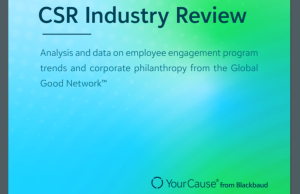By Richard H. Levey
When a nonprofit executive thinks of financial technology, the human component might not be the first aspect that jumps to mind. The phrase “nonprofit financial technology” usually conjures images of donor management systems, prospect propensity analysis programs or campaign management tools — but not the people operating them.
As it happens, the component that has the most to offer, and conversely can hinder use of this technology, is the one that draws a regular paycheck. But some potential nonprofit employees are undertrained for quickly changing roles in nonprofit financial tech — or not being given an opportunity to fill them at all.
“We’re finding people just don’t have the capacity,” said Techbridge Chief Operating Officer Barbara Augustin. “We’re also finding there are numerous opportunities, and nonprofits can’t hire fast enough.”
Atlanta-based Techbridge runs a tech skills school as part of its mission to break cyclical poverty. Techbridge focuses on often-overlooked members of the 18- to 24-year-old cohort, especially those who can aid organizations’ desire to promote diversity and inclusion. Many of its students arrive at the program via word of mouth, from organizations that want to develop the skill sets of existing employees. Within the past 18 months, the organization has placed around 600 of its students — an 85% to 90% placement rate — in positions that require the skills it teaches.
Techbridge focuses on starter careers within the nonprofit community, but its efforts help prime a diverse workforce for higher-level jobs. Nonprofit managers embracing Techbridge’s efforts aren’t necessarily doing so out of altruism. Having more diversity amid financial-related positions will help reduce unintentional institutional biases, such as overlooking funder markets or areas where its services might be needed, or even promoting the nonprofit in ways that inadvertently alienate various populations.
Part of these diversity efforts include offering training that reflects the changing role of financial-function employees, especially regarding their use of technology. “It’s important to have some data literacy, such as being able to understand, when you look at donor data, the difference between correlation and causation,” explained Tech Impact Managing Director of Education and Outreach Karen Graham. “That’s along with how to interpret charts and graphs and some basic skills in data analysis and visualization, so you can not only understand what you’re looking at but also share it appropriately with others, and persuasively with others in the case of fundraising.”
These skills might not be inherent to a potential employee. “At the hiring stage, there’s an expectation or a desire for people to have those kinds of skills,” Graham continued. “The next step for nonprofit organizations is going to be providing some professional development and accountability around improving those skills.”
Graham is comfortable eschewing looking for specific tech skills in favor of determining whether a candidate has an innate curiosity about how programs work. “When we hired for a marketing manager, we listed right on the program that we use HubSpot [marketing software] and it would be an advantage if you know how to use this tool — or if not, if you’re a fast learner. That’s a big interview question for us. Is a candidate afraid to just click around and find out how something works?”
According to Graham, the tech functions of nonprofit financial positions have changed within the past decade or two. Basic information technology functions are increasingly being outsourced, freeing financial managers to focus on higher-level functions.
Within nonprofits, tech roles have shifted, Graham added. “Finance directors are not necessarily having to have technology troubleshooting skills, or hands-on technical skills, but rather the kinds of skills necessary to supervise highly technical staff, to select vendors and service providers, and to make hires and manage people who are highly technical. They need to have some ability to assess return on investment for technology investments, and to assess cybersecurity risks, and to understand the opportunity cost of delaying investment in technology or continuing to work with substandard technology.”
These considerations play into how the Philadelphia-based nonprofit technology services organization recruits candidates for placement and offers training. Tech Impact specializes in reaching out to traditionally underrepresented populations in tech by forging relationships with historically black colleges and universities (HBCUs), or job boards that cater to other underrepresented populations.
The shift in focus reflects a new reality in nonprofit financial tech operations. “Technology should start to take humans out of the repetitive, the mundane, the low-value stuff that doesn’t really require human skill,” Sage Chief Technology Officer Aaron Harris said.
At the Newcastle upon Tyne, U.K.-based financial management software firm, leadership acknowledges that employees with financial tech acumen gain a stepping stone to greater responsibility within a nonprofit. “The users of finance and accounting products, by definition, are responsible for reporting on the performance of an organization, or leading that organization with their knowledge and performance to make the right decisions to grow,” Harris said.
“If you ask the CEO what her job is, her answer is not that it is to produce financial statements or ensure that donor funds are appropriately allocated,” Harris continued. The CFO’s job is to be an advocate for mission, and to make sure the organization can achieve that mission as effectively as possible with the resources it has available.
Making sure any nonprofit financial position has at its core furthering an organization’s purpose represents a valid shift in perspective. But there’s a conundrum that comes with that shift. Some financial management software, especially those powered with artificial intelligence capabilities, would seem to eliminate tasks within lower-level jobs that are foundational to performing well within upper-level positions.
Harris is sanguine on that topic. He believes the roles of lower-level positions have always changed. “In every big generation change in technology there’s a class of work that gets replaced with automation,” Harris said. “But we always see something that fills its place. It may be that nonprofits are able to reallocate their resources, so there’s less investment on low-value, repetitive work and more investment in working with constituents, working on their mission.” As these changes occur, as new classes of work develop, the paths that develop mid- and upper-level employees in nonprofit finance positions will change as well, Harris added.
The shift in the nature of financial tech jobs will have to be accompanied by more changes in education and training programs to better prepare potential employees for next-generation jobs, especially if those jobs will draw on abilities that traditionally would have required years of experience. “A lot of it is coming down to education and training,” Harris said.
Sage is putting money where Harris’s mouth is. Through its London-based Sage Foundation, the company runs a variety of relief programs. One, the Pathways Program, is geared toward helping nontraditional employees gain a toehold in the business world.
Program focuses are community specific: some, such as its efforts within the United States, replicate the effort of TechBridge among the BIPOC (Black, Indigenous, People of Color) population, as well as offering opportunities for military veterans and other populations. Other programs, such as an effort based in South Africa, work with people who have disabilities. In the United Kingdom, the main population served is “returners,” people who have been out of the workplace for an extended time.
Pathways has existed for three years, including an unintended hiatus in 2020 due to the coronavirus pandemic. When the program resurfaced in 2021, it had a new crop of individuals who had been out of the workforce. Of the enrollees who participated in returner training, which can last between six and nine months depending on what skills are taught, 125 of the 175 were female.
Sage Foundation’s work goes beyond helping potential employees, often hiring organizations needing coaching. “Normally, when a manager needs to hire someone, they take the job description from when they last hired,” Sage Foundation Vice President Helen Devanny said. “That’s wrong for many reasons.”
Pathways representatives will work with hiring managers and pare down job requirements, especially those that have become irrelevant or redundant with current staff.
“It’s an interesting exercise,” Devanny said. “They start off saying ‘we need all of this.’ Then you say, ‘Okay, explain why you need this particular skill set. Do you have anybody in the team who doesn’t have it?’ You have that conversation on each of the line items, and what you end up with is something much leaner, much more attractive [to a broader applicant pool], just with some small tweaks to what you are asking for.”
The final piece to the financial employee puzzle is how nonprofits can retain the individuals they’ve trained and brought along. Commercial enterprises are often able to offer larger salaries. But, nonprofits are not without their appeal to potential employees. “We’re going through a big shift in how people expect to be rewarded,” Harris said. “They value flexibility and work arrangements — how much do they work from home versus working in the office? They have different values around benefits: childcare, richer health benefits that go beyond basic care.”









